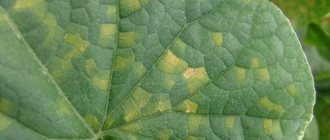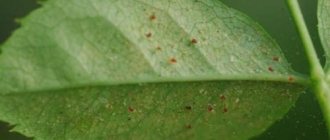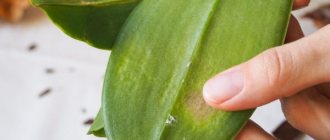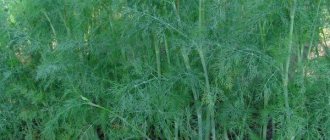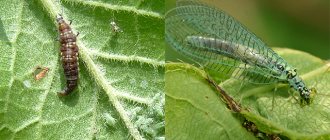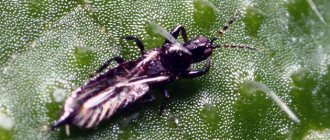Causes of geranium diseases
- In the presence of dark gray plaque on leaves, it is a sign of gray mold or rot. To prevent this, it is necessary to water the plant less and remove all damaged leaves from the stem as soon as possible. Geraniums will help renew the spraying with an antifungal drug.
- Powdery mildew is a fungal disease. The sign is covering the plant with a white bloom... This is facilitated by the increased temperature and humidity in the room where this plant is located. A good remedy can be a solution of copper sulfate, ammonium nitrate, soda ash, or a 5% solution made from water and laundry soap.
- Root rot it is very difficult to cure, geranium dies. Therefore, pay attention to watering. A large amount of moisture is very harmful to geraniums.
- A small white insect called a whitefly or aphid, settles on the leaves below and begins to multiply very quickly. They feed on geranium juice. From this the leaves turn yellow and fall off... Spraying with insecticides is required.
- Flower mold affects flowers. Its appearance can be determined by how brown mold forms on the stem... Mold must be removed in time, otherwise the flowers will begin to fade quickly, and the stems will begin to collapse.
- Black on the stem it is a manifestation of a black leg. The stems turn black, the leaves curl, begin to turn yellow and fall off. As a result, the geranium dies. When geraniums are transplanted, they should be planted in disinfected pots. Water only with clean water, not from barrels.
- When spotted leaves, this is a signal to exclude moisture and ventilate the room more often.
- Curl virus. The leaves of the plant acquire brown spots and begin to curl. In this case, the bush should be completely destroyed so that other plants do not become infected.
Symptoms and diagnoses
| Disease | Symptoms |
| Mushroom Botrytis | The flower is affected by a fungus against a background of high humidity. Withered leaves are covered with gray fluff. A brown bloom forms on the stems. Gradually, the stems rot. The flowers quickly fall off, previously covered with a gray bloom. |
| Root rot | The causative agents of the disease are Pythium or Rhizoctonia fungi. Leaves turn yellow first. Later, brown and then black spots appear on the affected areas. The flowers are covered with a gray or white bloom, resembling a cobweb. The stems start to rot, it feels like they are filled with water. After that, the flower dies. |
| Bacterial disease | Disease provocateurs are bacteria Xanthomonascampestrispv. pelargonii. Brown spots appear on the leaves, and the edges begin to dry out. If the infection occurs systemically, then the geranium becomes lethargic, the leaves fall off and the plant dies. |
| Leaf rust | In this case, the fungus Pucciniapelargonii-zonalis infects pelargonium. First, rusty-yellow leaves are formed on the leaves, and after that - pads with spores, which can open and throw them out. Over time, geranium leaves turn yellow, dry up and fall off. |
| Viruses | If the virus is present, the plant stops growing. It forms spots in the form of rings or depressions of a violet-brown color. |
| Leaf spot (cercospora and Alternaria) | The causative agents of the disease are fungi Alternaria and Cercospora.Bubble formations appear on the lower surface of the leaf. As the disease progresses, these formations become sunken, brown-yellow, resembling loose salt. This condition occurs with alternaria. With cercosporosis, white sunken areas appear on the leaves. Later they take on a grayish tint. After that, these areas darken and acquire a bulge. |
| Edema | It appears under certain conditions - during cool cloudy weather or when a combination of moist soil and moist cold air. First, chlorosis spots form on the leaf, which subsequently turn into a bubble filled with water. After that, the leaves completely fall off. |
Next, we will talk about the main diseases and pests of indoor geranium, show a photo of the "black leg" and other ailments, and then give recommendations for their treatment.
Why do geranium leaves dry?
Use our recommendations to prevent drying out of geranium leaves:
- The lower leaves fall off the plant, and the upper ones are elastic, but have yellow edges. In this case, an increase in the amount of water for irrigation is required. The geranium should not be placed in direct sunlight.
- If the root decays, transplant the plant into a new pot. Before that, be sure to check the root, and cut off the areas of its blackening. Then treat them with activated carbon, which is pre-crushed.
- If there are red spots on the leaves, this is a signal of a sharp temperature drop. Bring the plant indoors if it is outdoors.

Why do geranium leaves dry?
Insects-parasites and the fight against them
Pests attack an initially weak plant, achieving its complete death. The main parasites that affect geraniums are:
- Root worm... Appears if the soil is highly moistened. The insect eats the root system. To rehabilitate the geranium, the affected roots are cut off, after which the plant is immersed in hot water with its roots for several minutes. Then they are dried and sprinkled with charcoal. The root treated in this way is transferred to sterile soil.
- Mealybug... The pest resembles by its appearance white lumps that suck its juices from the plant. First of all, the flower must be isolated and the white lumps must be removed with your hands. After that, spray the plant with a soap-alcohol solution.
- Whitefly... It can be found on the inside of the sheet. To remove it, Aktar's medicine is more often used.
- Aphid... More often it affects a young plant. Its habitat is shoots, leaves and stems. You can remove pests by hand or by cutting off the affected stem.
- Caterpillar... The insect makes multiple holes in the stems into which the larvae are laid. In this case, Senpai or Lipidocide drugs help.
Attention! If the flower is on the verge of death, it is treated with insecticides such as Aktara, Actellik or Fufanon.
We suggest you watch a video about pelargonium pests:
How to care for geraniums to bloom?
The reasons why geranium does not bloom may be different:
- When the plant is not fed with potassium fertilizer, there is no flowering.
- When geraniums are planted in a large pot, the root system begins to develop, but does not begin to bloom. In this case, plant the flower in a small pot first. As soon as it grows, transplant into a large one.
- Watering the plant has a great effect on flowering. During this period, it should be abundant.
- In the spring, pruning is required so that a couple of shoots remain. You should not put geraniums in sunken and strongly sunlit places. Find a neutral spot.
Features of flower growth
Geranium can be called an unpretentious flower.She loves a lot of sun, warmth and soil that allows air and water to pass through. The content conditions are as follows:
- good watering in summer and moderate in winter;
- bright sunlight, but no direct rays;
- warm air;
- loose, well-drained soil;
- moderate fertilizing with nitrogen-phosphorus-potassium fertilizers;
- slightly acidic soil;
- pruning and pinching to form a bush.
Why do the leaves of room geranium turn yellow?
Here are the main reasons for this:
- A very cramped pot, the plant does not have enough space. Transplanting into a large pot will immediately fix this problem.
- It is important to properly care for geraniums during the winter season. During this period, it can be exposed to a draft and strong soil moisture. Never place it next to a radiator.
- Remember that drying out and waterlogging the soil harms the plant. Therefore, drainage should be done and the soil should be loosened more often.
- As soon as the fungus appears, immediately treat the entire plant with Bordeaux liquid.
- Plant growth can be stunted if you overfeed it with nitrogen fertilizer. It is better to feed it with potash fertilizer.
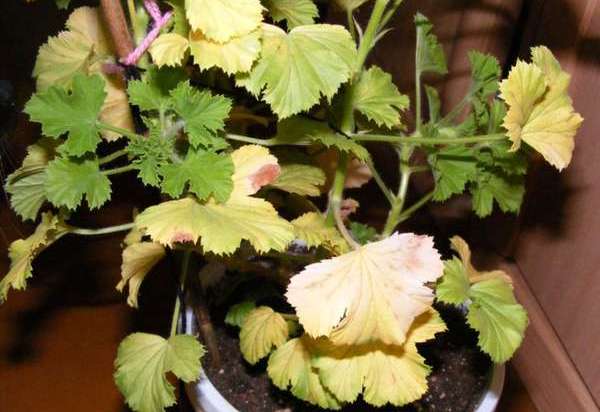

What to do if geranium leaves turn yellow? In order for the plant to grow normally, you do not need to forget about the introduction of organic and mineral fertilizers into the soil. This must be done in strict accordance with the dosage, otherwise it is impossible to prevent yellowing of the leaves. Fertilization with phosphate and potassium is very important.
Useful for geraniums, water with iodine. Pay special attention to geraniums in winter. At this time, yellow leaves appear most often on this plant. Therefore, you need to water 1-2 times a week, you do not need to add fertilizers. The room temperature should not be lower than 12 degrees. At the beginning of March, the plant is sprinkled, so you need to remove the dead leaves, having issued the desired size and shape of the flower.
With proper care of geraniums in winter, from March to December, it will enjoy its beauty of flowering and there will be no yellow leaves.
Disease prevention
It is possible to prevent the formation of pathological processes that are serious for a flower if the plant is provided with adequate care, including:
- observance of the basics of temperature conditions;
- control over humidity and dryness of the air;
- providing comfortable watering;
- organization of lighting;
- periodic application of dressings to the soil;
- timely treatment of early signs of disease;
- prevention of attacks of insect pests.


Why do geranium leaves turn white?
It also happens that geranium begins to release not even yellow, but white leaves. Moreover, old green leaves do not lose their green color.
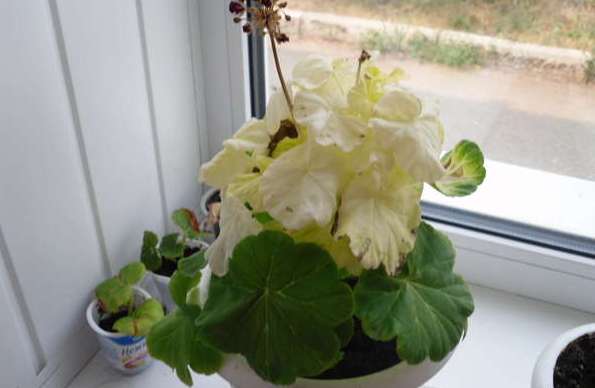

Why do geranium leaves turn white: the reason Why did geranium leaves turn white? As flower growers noticed, this happens in the hot season, when pelargonium is on the windowsill, in the sun itself and in the stagnant hot air. Typically, as the heat subsides, the geranium begins to release normal green leaves again.
You should not panic with white leaves of geranium: this is not chlorosis or pests, but simply the reaction of a plant to conditions that are unsuitable for it. Therefore, all we can do in this case is to try to make life easier for the plant during the summer heat (for example, move the plant to another windowsill, where the sun does not bake well).
How to get rid of the problem - detailed instructions
First of all, the flower is placed in quarantine so that other cultures in the apartment do not become infected from it. A close examination of the roots, soil, leaves, stems will help you make a correct diagnosis.
Rust
If your geranium is affected by rust, then you should take the following measures:
- rearrange the flowerpot with the plant in a dry and cool place;
- watering to a minimum;
- diseased leaves should be cut off;
- to process geranium with Topaz - a special preparation.
It should be understood that a flower can be cured only at the initial stage of infection.
Fungus
If the geranium is infected by the fungus Botrytis, you will have to act as follows:
- cut off all affected areas;
- treat with systemic fungicides;
- reduce watering;
- loosen the soil.
Ring spot
If this disease is affected, the flower cannot be cured.
As soon as you notice the first symptoms of ring spot, destroy the plant and the soil in which it was located.
Spider mite


It takes a lot of effort to get rid of a spider mite. It is worth noting that this parasite is a microscopic animal, therefore insecticides are useless... The algorithm of actions is as follows:
- Arrange a warm shower for the plant with laundry soap - this process destroys 50% of the entire population of the parasite.
- Rinse everything that stood next to the plant, disinfect the windowsill and window, wash the curtains.
- Spill the plant and pack in a plastic bag for 3 days. The mite does not tolerate high humidity.
All these actions will help only at the initial stage of the disease, if the cobweb has entangled the entire plant, it will have to be destroyed.
Alternaria
Often the plant is infected with this disease through the soil., you can cure it like this:
- change the soil in the flowerpot;
- process geraniums with Ridomil Gold or Skor;
- ventilate the room daily;
- loosen the soil;
- apply an optimal moisturizing regimen.
Insects can be removed in the following ways:
- Wash the flower with soapy water.
- Wipe with a cotton swab dipped in an alcohol solution.
- Treat with drugs.
Nutrient Deficiency
Flower nutrition problems can arise from soil conductivity or high pH levels. Outwardly, signs of a lack of any elements will appear only after 2-6 weeks.... What nutrition the flower will receive is influenced by the quality, quality and method of watering, as well as the shape of the pot.
The lack of phosphorus will first become noticeable on the reverse parts of the leaf plate (they will be covered with red spots), and then it will move to the upper part. Over time, the spots will turn brown and the leaves dry.
Zinc deficiency affects the shape of the leaves, pink and orange pigmentation appears on them... How to deal with this? Start feeding the geraniums with fertilizers. But do not overdo it, otherwise you will get the opposite result. In this difficult task, it is important to find a middle ground.

